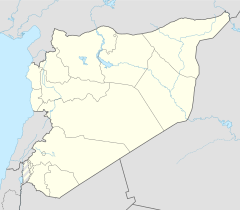| Jabal Sais جبل سايس | |
|---|---|
| General information | |
| Town or city | Rif Dimashq |
| Country | Syria |
| Coordinates | 33°18′11″N 37°21′34″E / 33.303116°N 37.359575°E |
| Technical details | |
| Material | adobe |
Jabal Sais ( Arabic: جبل سايس also known as Qasr Says is a Umayyad desert fortification or former palace in Syria which was built 707-715 AD. The fortification sits near an extinct volcano. [1] Jabal Says is mountain peak next to the fortification which sits 621 meters above sea level. [2]
History
Built from 707-715 AD and located in the Syrian Desert. [3] The location was dependent on the seasonal supply of water which pooled next to the volcano crater. The palace is now just a vestige. [4] The settlement at Jabal Says has existed since 528 AD. [5] According to the historian Jere L. Bacharach, al-Walid I built Jabal Says, likely as a Bedouin summer encampment between his base of operations in al-Qaryatayn and another of his desert forts, Qasr Burqu'. [6]
Jebel Usays inscription
The site contains a famous inscription known as the Jebel Usays inscription composed either in 528 or 532/3 AD. It describes the Jafnid leader Al-Harith ibn Jabalah with the leader al-malik, corresponding to how the title is spelt in Syriac texts from the time. [7] [8]
See also
Notes
- ^ Barker, Graeme (1999). Companion Encyclopedia of Archeology Volume 1-2. London: Routledge. p. 1086. ISBN 9781134921935. Archived from the original on 26 February 2022. Retrieved 13 December 2021.
- ^ "Jabal Says". Geo View. Archived from the original on 13 December 2021. Retrieved 13 December 2021.
- ^ Ruggles, D. Fairchild (2008). Islamic Gardens and Landscapes. Philadelphia Pennsylvania: University of Pennsylvanian Press. p. 15. ISBN 978-0812207286. Archived from the original on 26 February 2022. Retrieved 13 December 2021.
- ^ "Remains of the Ummayad Palace in Jabal Says". Syrian Heritage. Syrian Heritage Archive. Archived from the original on 13 December 2021. Retrieved 13 December 2021.
- ^ Fisher, Greg (3 December 2019). Rome, Persia, and Arabia : shaping the Middle East from Pompey to Muhammad. Abingdon, Oxon: Routledge. ISBN 978-0415728805. Archived from the original on 26 February 2022. Retrieved 13 December 2021.
- ^ Bacharach, Jere L. (1996). "Marwanid Umayyad Building Activities: Speculations on Patronage". In Necpoğlu, Gülru (ed.). Muqarnas: An Annual on the Visual Culture of the Islamic World, Volume 13. Leiden: Brill. pp. 31–32. ISBN 90-04-10633-2.
- ^ Fisher, Greg (2020). Rome, Persia, and Arabia: shaping the Middle East from Pompey to Muhammad. London New York: Routledge, Taylor & Francis Group. pp. 128, 140. ISBN 978-0-415-72880-5.
- ^ Genequand, Denis (2015). "The Archaeological Evidence for the Jafnisa and the Naṣrids". In Fisher, Greg (ed.). Arabs and empires before Islam. Oxford, United Kingdom: Oxford University Press. pp. 175–193. ISBN 978-0-19-965452-9.


